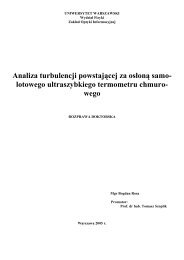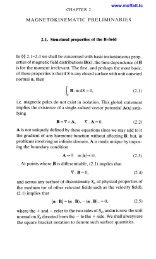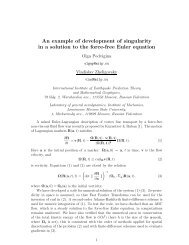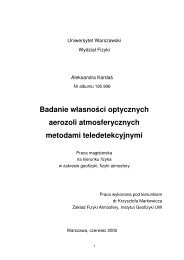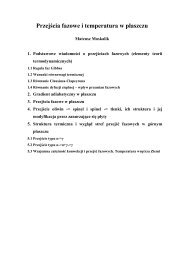A similarity solution for viscous source flow on a vertical plane
A similarity solution for viscous source flow on a vertical plane
A similarity solution for viscous source flow on a vertical plane
You also want an ePaper? Increase the reach of your titles
YUMPU automatically turns print PDFs into web optimized ePapers that Google loves.
Euro. Jnl of Applied Mathematics (1997), ol. 8,pp. 37–47. 1997 Cambridge University Press 37<br />
A <str<strong>on</strong>g>similarity</str<strong>on</strong>g> <str<strong>on</strong>g>soluti<strong>on</strong></str<strong>on</strong>g> <str<strong>on</strong>g>for</str<strong>on</strong>g> <str<strong>on</strong>g>viscous</str<strong>on</strong>g> <str<strong>on</strong>g>source</str<strong>on</strong>g> <str<strong>on</strong>g>flow</str<strong>on</strong>g> <strong>on</strong> a<br />
<strong>vertical</strong> <strong>plane</strong><br />
B. R. DUFFY and H. K. MOFFATT<br />
Department of Mathematics, Uniersity of Strathclyde, Liingst<strong>on</strong>e Tower, 26 Richm<strong>on</strong>d Street,<br />
Glasgow G1 1XH, UK<br />
Department of Applied Mathematics and Theoretical Physics, Siler Street, Cambridge CB3 9EW, UK<br />
(Receied in reised <str<strong>on</strong>g>for</str<strong>on</strong>g>m 29 August 1995)<br />
A thin-film approximati<strong>on</strong> is used in an analysis of the <str<strong>on</strong>g>flow</str<strong>on</strong>g> of a thin trickle of <str<strong>on</strong>g>viscous</str<strong>on</strong>g> fluid<br />
down a near-<strong>vertical</strong> <strong>plane</strong>. An approximate <str<strong>on</strong>g>similarity</str<strong>on</strong>g> <str<strong>on</strong>g>soluti<strong>on</strong></str<strong>on</strong>g> is obtained, representing<br />
essentially a <str<strong>on</strong>g>source</str<strong>on</strong>g> (or sink) <str<strong>on</strong>g>flow</str<strong>on</strong>g>. Several interpretati<strong>on</strong>s of the <str<strong>on</strong>g>soluti<strong>on</strong></str<strong>on</strong>g> are discussed.<br />
1 Introducti<strong>on</strong><br />
Problems c<strong>on</strong>cerning the ‘draining’ of <str<strong>on</strong>g>viscous</str<strong>on</strong>g> films down inclined surfaces have received<br />
much attenti<strong>on</strong> in the literature. In this paper we use a thin-film approximati<strong>on</strong> to study<br />
the steady spreading or c<strong>on</strong>tracti<strong>on</strong> of <str<strong>on</strong>g>viscous</str<strong>on</strong>g> liquid supplied (at a prescribed rate) <strong>on</strong> a<br />
near-<strong>vertical</strong> <strong>plane</strong>; gravity may be c<strong>on</strong>sidered the ‘main’ driving <str<strong>on</strong>g>for</str<strong>on</strong>g>ce, but surface tensi<strong>on</strong><br />
cannot be neglected. The assumpti<strong>on</strong> that the <str<strong>on</strong>g>flow</str<strong>on</strong>g> changes <strong>on</strong>ly slowly down the <strong>plane</strong> then<br />
leads to an approximate <str<strong>on</strong>g>similarity</str<strong>on</strong>g> <str<strong>on</strong>g>soluti<strong>on</strong></str<strong>on</strong>g> <str<strong>on</strong>g>for</str<strong>on</strong>g> this three-dimensi<strong>on</strong>al <str<strong>on</strong>g>viscous</str<strong>on</strong>g> free-surface<br />
<str<strong>on</strong>g>flow</str<strong>on</strong>g>. Several interpretati<strong>on</strong>s of this <str<strong>on</strong>g>soluti<strong>on</strong></str<strong>on</strong>g> are discussed.<br />
Only steady <str<strong>on</strong>g>flow</str<strong>on</strong>g>s are c<strong>on</strong>sidered, so that, in particular, any c<strong>on</strong>tact lines are fixed;<br />
difficulties associated with moving c<strong>on</strong>tact lines are thereby avoided. (Cf. Davis, 1983, and<br />
the many references therein.) Unsteady <str<strong>on</strong>g>flow</str<strong>on</strong>g>s have been c<strong>on</strong>sidered (within a thin-film<br />
theory) by, <str<strong>on</strong>g>for</str<strong>on</strong>g> example, Huppert (1982), Schwartz (1989), Lister (1992) and Moriarty et al.<br />
(1991).<br />
2 The governing equati<strong>on</strong>, and a <str<strong>on</strong>g>similarity</str<strong>on</strong>g> <str<strong>on</strong>g>soluti<strong>on</strong></str<strong>on</strong>g><br />
If liquid is supplied (at a prescribed volume flux Q) from a point <str<strong>on</strong>g>source</str<strong>on</strong>g> <strong>on</strong> an inclined<br />
<strong>plane</strong>, then there will be an adjustment regi<strong>on</strong> where the trickle widens (from ‘zero’ width)<br />
until it attains a c<strong>on</strong>stant cross secti<strong>on</strong>, of n<strong>on</strong>-zero width 2a (say). There will be a similar<br />
adjustment if the <str<strong>on</strong>g>source</str<strong>on</strong>g> is of small but n<strong>on</strong>-zero width. If the liquid is supplied from a very<br />
wide <str<strong>on</strong>g>source</str<strong>on</strong>g>, then it is comm<strong>on</strong>ly observed that an ‘instability’ occurs, and the stream splits<br />
into two or more narrower trickles (fingers), each of which is eventually a uni<str<strong>on</strong>g>for</str<strong>on</strong>g>m rivulet.<br />
Again, there will be adjustment regi<strong>on</strong>s where the width of each trickle settles to an<br />
appropriate value of a (although determinati<strong>on</strong> of these values of a is by no means<br />
straight<str<strong>on</strong>g>for</str<strong>on</strong>g>ward; see, <str<strong>on</strong>g>for</str<strong>on</strong>g> example, Mikielewicz & Moszynski, 1978; Huppert, 1982;<br />
Schwartz, 1989).<br />
Smith (1973) has c<strong>on</strong>sidered the spreading of a trickle from a point <str<strong>on</strong>g>source</str<strong>on</strong>g> <strong>on</strong> an inclined<br />
<strong>plane</strong> in the case when surface tensi<strong>on</strong> is negligible. However, when the <strong>plane</strong> is <strong>vertical</strong> the
38 B. R. Duffy and H. K. Moffatt<br />
FIGURE 1. A trickle of fluid emitted <strong>on</strong> a near-<strong>vertical</strong> plate.<br />
effects of surface tensi<strong>on</strong> cannot be ignored; we c<strong>on</strong>sider this case here, again taking the<br />
film to be thin and the <str<strong>on</strong>g>flow</str<strong>on</strong>g> to be slow.<br />
Suppose a thin film of Newt<strong>on</strong>ian liquid, of c<strong>on</strong>stant density ρ and viscosity µ, is <str<strong>on</strong>g>flow</str<strong>on</strong>g>ing<br />
down a <strong>plane</strong> inclined at an angle α to the horiz<strong>on</strong>tal, α being defined such that the liquid<br />
is <strong>on</strong> the ‘topside’ of the <strong>plane</strong> when α <br />
π and is <strong>on</strong> the ‘underside’ of the <strong>plane</strong> when<br />
α <br />
π (see Figure 1). We shall take the <strong>plane</strong> to be <strong>vertical</strong> or nearly <strong>vertical</strong>, so that α <br />
π<br />
is zero or is small.<br />
We use Cartesian coordinates Oxyz as in Figure 1, with Ox down a line of greatest slope<br />
and with Oz normal to the <strong>plane</strong>. A standard thin-film analysis shows that the (generally<br />
unsteady) free-surface profile z h(x, y, t) satisfies<br />
3µh t<br />
[h(ρgh cos αγ h)]3ρgh h x<br />
sin α, (2.1)<br />
where γ denotes the coefficient of surface tensi<strong>on</strong> (assumed c<strong>on</strong>stant), g denotes the<br />
accelerati<strong>on</strong> due to gravity, and suffixes denote partial differentiati<strong>on</strong>.<br />
The case of a rivulet of uni<str<strong>on</strong>g>for</str<strong>on</strong>g>m width is obtained by putting h h(y) and setting to zero<br />
the term in square brackets in (2.1):<br />
ρgh cos αγh yy<br />
c<strong>on</strong>stant.<br />
(cf. Towell & Rothfeld, 1966; Allen & Biggin, 1974). This is to be integrated subject to the<br />
boundary c<strong>on</strong>diti<strong>on</strong>s<br />
h 0 and htan β <br />
at y a,<br />
where a is the semi-width of the trickle, and β <br />
is the c<strong>on</strong>tact angle at the air–liquid–solid<br />
c<strong>on</strong>tact line, taken to be c<strong>on</strong>stant. For small α <br />
π the <str<strong>on</strong>g>soluti<strong>on</strong></str<strong>on</strong>g> is<br />
h(y) tan β <br />
2a<br />
(ay).
A <str<strong>on</strong>g>similarity</str<strong>on</strong>g> <str<strong>on</strong>g>soluti<strong>on</strong></str<strong>on</strong>g> <str<strong>on</strong>g>for</str<strong>on</strong>g> iscous <str<strong>on</strong>g>source</str<strong>on</strong>g> <str<strong>on</strong>g>flow</str<strong>on</strong>g> <strong>on</strong> a ertical <strong>plane</strong> 39<br />
The velocity comp<strong>on</strong>ent down the <strong>plane</strong> is u (ρg sin α2µ)(2hzz), and the volume flux<br />
of liquid running down the <strong>plane</strong> is<br />
Q a −a h(y) udzdy, ρgsin α<br />
3µ a<br />
<br />
−a<br />
h dy, 4ρga sin α tan β ,<br />
105µ<br />
independent of γ (in this approximati<strong>on</strong>).<br />
In general, liquid issuing from a <str<strong>on</strong>g>source</str<strong>on</strong>g> (whether a point <str<strong>on</strong>g>source</str<strong>on</strong>g> or a distributed <str<strong>on</strong>g>source</str<strong>on</strong>g>)<br />
will not have this profile, and there will be some sort of adjustment z<strong>on</strong>e be<str<strong>on</strong>g>for</str<strong>on</strong>g>e a c<strong>on</strong>stant<br />
profile can be attained. Smith (1973) has studied this adjustment <str<strong>on</strong>g>for</str<strong>on</strong>g> the case when α is not<br />
near <br />
π, with surface tensi<strong>on</strong> neglected (at leading order). We, <strong>on</strong> the other hand, are<br />
interested in a near-<strong>vertical</strong> surface, so that α <br />
π, and surface tensi<strong>on</strong> cannot be neglected.<br />
In the spirit of Smith’s analysis, we seek a steady <str<strong>on</strong>g>soluti<strong>on</strong></str<strong>on</strong>g> <str<strong>on</strong>g>for</str<strong>on</strong>g> which the length scale down<br />
the <strong>plane</strong> is much greater than that across the stream, so that h y<br />
h x<br />
in general. Then<br />
equati<strong>on</strong> (21) becomes approximately<br />
hh yyyy<br />
3h y<br />
h yyy<br />
3(ρg sin αγ) h x<br />
0. (2.2)<br />
The self-c<strong>on</strong>sistency of this approximati<strong>on</strong> is checked a posteriori (see equati<strong>on</strong>s (212) and<br />
(213)) by verifying that 1 h y<br />
h x<br />
<str<strong>on</strong>g>for</str<strong>on</strong>g> the <str<strong>on</strong>g>soluti<strong>on</strong></str<strong>on</strong>g> obtained; a more <str<strong>on</strong>g>for</str<strong>on</strong>g>mal justificati<strong>on</strong><br />
of the approximati<strong>on</strong> is given in an appendix.<br />
Here we shall c<strong>on</strong>sider <str<strong>on</strong>g>soluti<strong>on</strong></str<strong>on</strong>g>s of (22) that are symmetrical about y 0, or, to be more<br />
precise, <str<strong>on</strong>g>soluti<strong>on</strong></str<strong>on</strong>g>s <str<strong>on</strong>g>for</str<strong>on</strong>g> which h is even in y. This means that<br />
h y<br />
(x,0)0, h yyy<br />
(x,0)0. (2.3)<br />
We take the free-surface to meet the <strong>plane</strong> z 0 in the curves y y e<br />
(x), which are<br />
there<str<strong>on</strong>g>for</str<strong>on</strong>g>e three-phase c<strong>on</strong>tact lines (the ‘edges’ of the trickle). Then<br />
h(x, y e<br />
) 0. (2.4)<br />
Also, the volume flux of liquid down the <strong>plane</strong> is approximately<br />
ρg sin α<br />
Q <br />
3µ y e(x)<br />
h dy, (2.5)<br />
−y e (x)<br />
and herein we take Q to be a prescribed c<strong>on</strong>stant.<br />
It is expected that the c<strong>on</strong>tact angle β at the (anchored) three-phase lines y y e<br />
(x) will<br />
satisfy a restricti<strong>on</strong> of the <str<strong>on</strong>g>for</str<strong>on</strong>g>m β r<br />
β β a<br />
, where β r<br />
and β a<br />
are c<strong>on</strong>stants (the receding and<br />
advancing c<strong>on</strong>tact angles). However, there is no reas<strong>on</strong> to expect β itself to be c<strong>on</strong>stant <strong>on</strong><br />
these c<strong>on</strong>tact lines (and indeed, simple observati<strong>on</strong>s of film-drainage down an inclined<br />
<strong>plane</strong> suggest str<strong>on</strong>gly that β will vary quite c<strong>on</strong>siderably, at least where the film width<br />
varies in a downstream directi<strong>on</strong>). Presumably c<strong>on</strong>diti<strong>on</strong>s near the lateral c<strong>on</strong>tact lines are<br />
dominated by <str<strong>on</strong>g>viscous</str<strong>on</strong>g> stresses, in which case it is legitimate to assume that the c<strong>on</strong>tact angle<br />
adjusts itself locally to the value dictated by these stresses. There may, of course, be an<br />
‘inner regi<strong>on</strong>’ (perhaps <strong>on</strong> the scale of intermolecular <str<strong>on</strong>g>for</str<strong>on</strong>g>ces) within which an adjustment<br />
to the appropriate c<strong>on</strong>tact angle takes place; however, the behaviour in such an inner<br />
regi<strong>on</strong> lies outside the scope of the present analysis. We there<str<strong>on</strong>g>for</str<strong>on</strong>g>e leave open the questi<strong>on</strong>
40 B. R. Duffy and H. K. Moffatt<br />
of the c<strong>on</strong>tact-angle, and merely report a family of free-surface profiles that are c<strong>on</strong>sistent<br />
with (2.2)–(2.5), and <str<strong>on</strong>g>for</str<strong>on</strong>g> which, as we shall see, β is variable.<br />
We seek a <str<strong>on</strong>g>similarity</str<strong>on</strong>g> <str<strong>on</strong>g>soluti<strong>on</strong></str<strong>on</strong>g> to (2.2) of the <str<strong>on</strong>g>for</str<strong>on</strong>g>m<br />
h(x, y) f(x) G(η),<br />
η yy e<br />
(x),<br />
so that G(1) 0.<br />
Substituti<strong>on</strong> of this <str<strong>on</strong>g>for</str<strong>on</strong>g>m of h into (2.2) shows that appropriate f and y e<br />
are<br />
f(x) A(cx)m, y e<br />
(x) (cx)n, m4n1 0,<br />
where c, A, m and n are c<strong>on</strong>stants (a shift of origin having been made, to eliminate any<br />
additive c<strong>on</strong>stant in x). The c<strong>on</strong>stancy of Q further implies that 3mn 0, so that<br />
m 113 and n 313. The c<strong>on</strong>stant A( 0) may be chosen freely, and if we make the<br />
choice A cρg sin α104γ (so that c and A have physical dimensi<strong>on</strong>s (length)/ and<br />
(length)/, respectively) then the equati<strong>on</strong> <str<strong>on</strong>g>for</str<strong>on</strong>g> G(η) is<br />
GG3GG24(G3ηG) 0,<br />
i.e.<br />
G(G24η) c<strong>on</strong>stant.<br />
For the symmetrical <str<strong>on</strong>g>soluti<strong>on</strong></str<strong>on</strong>g>s that we are c<strong>on</strong>sidering here, we have G 0 when η 0,<br />
so that the c<strong>on</strong>stant of integrati<strong>on</strong> is 0. Thus G 24η, and, trivially, the <str<strong>on</strong>g>soluti<strong>on</strong></str<strong>on</strong>g><br />
satisfying G(1) 0is<br />
G(η)(η1)λ(η1), (2.6)<br />
where λ is some c<strong>on</strong>stant. The flux c<strong>on</strong>diti<strong>on</strong> gives a relati<strong>on</strong> between c and λ:<br />
(ρg sin α) c<br />
Q <br />
2313γµ G dη, (2.7)<br />
−<br />
which reduces to c P(λ) Nγ µ Q, (2.8)<br />
(ρg sin α)<br />
where N 235713 3690960 and<br />
P(λ) λλ<br />
λ . (2.9)<br />
This cubic polynomial P(λ) is m<strong>on</strong>ot<strong>on</strong>ic in λ, with real root λ ( 1.184). <br />
Thus, overall we have<br />
cρg sin α<br />
h(x, y) <br />
104γ (cx) −/ G(η), (2.10)<br />
where η yy e<br />
(x), y e<br />
(x) (cx)/, (2.11)<br />
with G(η) as in (2.6) and with (2.8) holding. The quartic functi<strong>on</strong> G(η) essentially gives the<br />
cross-secti<strong>on</strong>al shape of the trickle at each stati<strong>on</strong> x c<strong>on</strong>stant; we shall find interpretati<strong>on</strong>s<br />
of the <str<strong>on</strong>g>soluti<strong>on</strong></str<strong>on</strong>g> <str<strong>on</strong>g>for</str<strong>on</strong>g> both positive and negative values of the c<strong>on</strong>stant c, valid <str<strong>on</strong>g>for</str<strong>on</strong>g> G(η) 0
A <str<strong>on</strong>g>similarity</str<strong>on</strong>g> <str<strong>on</strong>g>soluti<strong>on</strong></str<strong>on</strong>g> <str<strong>on</strong>g>for</str<strong>on</strong>g> iscous <str<strong>on</strong>g>source</str<strong>on</strong>g> <str<strong>on</strong>g>flow</str<strong>on</strong>g> <strong>on</strong> a ertical <strong>plane</strong> 41<br />
FIGURE 2. Cross-secti<strong>on</strong>al profiles given by the functi<strong>on</strong> G(η) in equati<strong>on</strong> (2.6), <str<strong>on</strong>g>for</str<strong>on</strong>g> (a) λ 2,<br />
(b) λ 2, (c) 1 λ 2, (d) λ 1, (e) 0 λ 1, (f) λ 0. In (a) and (c) κ (λ1)/.<br />
and G(η) 0, respectively (see equati<strong>on</strong> (3.3)). Figure 2 shows the <str<strong>on</strong>g>for</str<strong>on</strong>g>ms of G(η) <str<strong>on</strong>g>for</str<strong>on</strong>g> the<br />
cases (a) λ 2, (b) λ 2, (c) 1 λ 2, (d) λ 1, (e) 0 λ 1, (f) λ 0. The depth of<br />
the trickle varies like x−/, and y e<br />
gives its ‘spread’ as it runs down the <strong>plane</strong>. (Of course,<br />
as this is a <str<strong>on</strong>g>similarity</str<strong>on</strong>g> <str<strong>on</strong>g>soluti<strong>on</strong></str<strong>on</strong>g>, the profile is essentially the same at each x-stati<strong>on</strong>, merely<br />
scaled in depth by x−/ and in width by x/. Also at a given x-stati<strong>on</strong> the depth and width<br />
(<str<strong>on</strong>g>for</str<strong>on</strong>g> a given λ) are proporti<strong>on</strong>al to Q/ and Q/.)<br />
We expect the <str<strong>on</strong>g>soluti<strong>on</strong></str<strong>on</strong>g> to be valid if 1 h y<br />
h x<br />
in general; evaluati<strong>on</strong> of these<br />
inequalities at the ‘typical’ value η 1 shows that<br />
(λ2) ρgc sin α<br />
cx 52γ / and cx 13 3c / , (2.12)<br />
which imply essentially that the <str<strong>on</strong>g>soluti<strong>on</strong></str<strong>on</strong>g> can be valid <strong>on</strong>ly well away from the origin. Also,<br />
with the above <str<strong>on</strong>g>for</str<strong>on</strong>g>m <str<strong>on</strong>g>for</str<strong>on</strong>g> h the neglected term ρgh cos α in (2.1) (associated with lateral<br />
spreading due to gravity) is much smaller than the retained term γh if<br />
12γ<br />
cx ρgλ cos α / (2.13)<br />
(which in fact imposes no restricti<strong>on</strong> in the case when α is exactly π2).
5<br />
8<br />
42 B. R. Duffy and H. K. Moffatt<br />
The governing equati<strong>on</strong>s (2.2) and (2.4) involve the two length scales<br />
L <br />
(γρg sin α)/ and L <br />
(µQρg sin α)/ (2.14)<br />
(which are prescribed quantities). There is there<str<strong>on</strong>g>for</str<strong>on</strong>g>e some freedom in choosing n<strong>on</strong>dimensi<strong>on</strong>al<br />
variables. With the scheme<br />
x kL x , y kL y , y e<br />
kL y e , h k L h 104, c (kL )/ c , (2.15)<br />
<br />
where k N/(L L )/, the <str<strong>on</strong>g>soluti<strong>on</strong></str<strong>on</strong>g> may be written in the <str<strong>on</strong>g>for</str<strong>on</strong>g>m<br />
<br />
h (x , y ) <br />
G(η)<br />
x /[P(λ)]/ ,<br />
η y , y<br />
y e P(λ) x / , (2.16)<br />
e<br />
with G(η) and P(λ) as in (2.6) and (2.9). The <str<strong>on</strong>g>soluti<strong>on</strong></str<strong>on</strong>g> involves <strong>on</strong>e free parameter, here<br />
taken to be λ; thus (2.16) represents a family of <str<strong>on</strong>g>soluti<strong>on</strong></str<strong>on</strong>g>s, with parameter λ.<br />
The analysis is valid <str<strong>on</strong>g>for</str<strong>on</strong>g> both c 0 and c 0, provided that y e<br />
and h are positive; this<br />
means that cx 0, that cG 0, and that the η-domain must be chosen such that G(η) is<br />
of <strong>on</strong>e sign.<br />
3 Interpretati<strong>on</strong> of the <str<strong>on</strong>g>soluti<strong>on</strong></str<strong>on</strong>g><br />
(i) For all cases except case (c) we take η 1 <str<strong>on</strong>g>for</str<strong>on</strong>g> the moment. Case (c) is different in that<br />
the corresp<strong>on</strong>ding interval <str<strong>on</strong>g>for</str<strong>on</strong>g> η is η κ, where κ (λ1)/ (with 1 λ 2); thus, <str<strong>on</strong>g>for</str<strong>on</strong>g><br />
example, the integrati<strong>on</strong> limits in equati<strong>on</strong> (2.7) <str<strong>on</strong>g>for</str<strong>on</strong>g> case (c) should be κ, rather than 1.<br />
However, <strong>on</strong>e can show easily that under the change of variables<br />
η η*(λ*1)/, (λ1)(λ*1) 1, c c*(λ*1)/, y e<br />
(λ*1)/ y e<br />
,<br />
the <str<strong>on</strong>g>soluti<strong>on</strong></str<strong>on</strong>g> <str<strong>on</strong>g>for</str<strong>on</strong>g> case (c) becomes the same as that <str<strong>on</strong>g>for</str<strong>on</strong>g> case (a), with η, λ, c and y e<br />
replaced<br />
by η*, λ*, c* and y e<br />
, and with η* 1. This means that case (c) can be subsumed into case<br />
(a), and need not be treated separately.<br />
In all cases, then, the c<strong>on</strong>tact angle β(x) atyy e<br />
and the centre-line depth h <br />
(x) of the<br />
liquid are given approximately by<br />
tan β h (λ2) cρg sin α<br />
<br />
y y=ye<br />
52γ(cx)/<br />
(3.1)<br />
and<br />
h <br />
h(x,0)<br />
(λ1) cρg sin α<br />
. (3.2)<br />
104γ(cx)/<br />
Note that in this <str<strong>on</strong>g>soluti<strong>on</strong></str<strong>on</strong>g> β varies round the c<strong>on</strong>tact line (except when λ 2), and cannot<br />
be prescribed. (Smith’s <str<strong>on</strong>g>soluti<strong>on</strong></str<strong>on</strong>g> has a similar feature.) It is expected that (3.1) can hold <strong>on</strong>ly<br />
where β r<br />
β β a<br />
.<br />
The c<strong>on</strong>diti<strong>on</strong> Q 0 requires that λ λ <br />
if c 0 and λ λ <br />
if c 0. In additi<strong>on</strong> the<br />
c<strong>on</strong>diti<strong>on</strong>s h <br />
0 and 0 tan β ( 1) require that<br />
either I: c 0, x 0, λ 2, G(η) 0 (cases (a), (b)),<br />
or II: c 0, x 0, λ 1, G(η) 0 (cases (d), (e), (f))<br />
(both of which give Q 0 and h(x, y) 0, as required).<br />
6<br />
7<br />
(3.3)
A <str<strong>on</strong>g>similarity</str<strong>on</strong>g> <str<strong>on</strong>g>soluti<strong>on</strong></str<strong>on</strong>g> <str<strong>on</strong>g>for</str<strong>on</strong>g> iscous <str<strong>on</strong>g>source</str<strong>on</strong>g> <str<strong>on</strong>g>flow</str<strong>on</strong>g> <strong>on</strong> a ertical <strong>plane</strong> 43<br />
FIGURE 3. The free-surface shape predicted by the <str<strong>on</strong>g>similarity</str<strong>on</strong>g> <str<strong>on</strong>g>soluti<strong>on</strong></str<strong>on</strong>g> (2.16) in the case λ 0. This is<br />
of type II, i.e. getting narrower and deeper downstream. The inset shows the cross-secti<strong>on</strong>al profile<br />
(cf. Figure 2).<br />
A <str<strong>on</strong>g>soluti<strong>on</strong></str<strong>on</strong>g> of type I describes <str<strong>on</strong>g>flow</str<strong>on</strong>g> (in x 0) from a <str<strong>on</strong>g>source</str<strong>on</strong>g> at x 0, the trickle getting<br />
wider (like x/) and shallower (like x−/) with distance x down the <strong>plane</strong>. A <str<strong>on</strong>g>soluti<strong>on</strong></str<strong>on</strong>g> of<br />
type II describes <str<strong>on</strong>g>flow</str<strong>on</strong>g> (in x 0) into a sink at x 0, the trickle getting narrower and deeper<br />
down the <strong>plane</strong>. In type-II <str<strong>on</strong>g>soluti<strong>on</strong></str<strong>on</strong>g>s the lateral c<strong>on</strong>tracti<strong>on</strong> can c<strong>on</strong>tinue <strong>on</strong>ly until the<br />
depth becomes so great (and the c<strong>on</strong>tact angle becomes so big) that the fluid ‘spills over’<br />
and runs down the <strong>plane</strong> as a uni<str<strong>on</strong>g>for</str<strong>on</strong>g>m trickle.<br />
Both types of <str<strong>on</strong>g>soluti<strong>on</strong></str<strong>on</strong>g> are symmetric about the mid-line η 0. As may be seen in Figure<br />
2, in all cases except (e) the cross secti<strong>on</strong> of the trickle (at a fixed x-stati<strong>on</strong>) has a single<br />
maximum, at y 0. In case (e) (<str<strong>on</strong>g>for</str<strong>on</strong>g> which h has the sign of G) the cross secti<strong>on</strong> is ‘doublehumped’,<br />
with maxima at η (λ2)/ and a minimum at η 0. Figures 3, 4 and 5 show<br />
examples of free-surface profiles <str<strong>on</strong>g>for</str<strong>on</strong>g> three representative values of the parameter λ; the first<br />
two are of type II and the latter is of type I.<br />
(ii) C<strong>on</strong>sider now case (c) with 1 λ λ . In the interval κ η 1 we have G(η) 0,<br />
<br />
c 0 and x 0; also the limits in the integral in (2.7) become η κ to η 1. The <str<strong>on</strong>g>soluti<strong>on</strong></str<strong>on</strong>g><br />
in this interval represents <str<strong>on</strong>g>flow</str<strong>on</strong>g> (into a sink at x 0) of a ‘meandering’ trickle occupying<br />
κy e<br />
y y e<br />
(<str<strong>on</strong>g>for</str<strong>on</strong>g> x 0); the trickle veers away from the line of greatest slope, and gets<br />
narrower and deeper as the sink is approached. Thus overall the trickle is highly<br />
asymmetrical in y, even though G is even in η. (There is a similar interpretati<strong>on</strong> <str<strong>on</strong>g>for</str<strong>on</strong>g> the<br />
<str<strong>on</strong>g>soluti<strong>on</strong></str<strong>on</strong>g> in 1 η κ.)<br />
(iii) C<strong>on</strong>sider cases (a) and (b) with η κ, so that G(η) 0, c 0, λ 2 and x 0.<br />
Roughly speaking, these corresp<strong>on</strong>d to <str<strong>on</strong>g>flow</str<strong>on</strong>g> of a liquid sheet around the outside of the<br />
regi<strong>on</strong> y e<br />
y y e<br />
; thus this regi<strong>on</strong> (which, since x 0, gets wider with increasing x) is
44 B. R. Duffy and H. K. Moffatt<br />
FIGURE 4. The free-surface shape in the case λ 0.9. This is of type II.<br />
FIGURE 5. The free-surface shape in the case λ 3. This is of type I, i.e. getting wider and<br />
shallower downstream.
A <str<strong>on</strong>g>similarity</str<strong>on</strong>g> <str<strong>on</strong>g>soluti<strong>on</strong></str<strong>on</strong>g> <str<strong>on</strong>g>for</str<strong>on</strong>g> iscous <str<strong>on</strong>g>source</str<strong>on</strong>g> <str<strong>on</strong>g>flow</str<strong>on</strong>g> <strong>on</strong> a ertical <strong>plane</strong> 45<br />
a ‘dry patch’, with liquid <strong>on</strong> either side. However, the liquid sheet extends to y <br />
outside the dry patch, and the volume flux Q of liquid down the <strong>plane</strong> is infinite.<br />
4 Comments<br />
(i) Simple experiments were per<str<strong>on</strong>g>for</str<strong>on</strong>g>med with large ‘drops’ of syrup <strong>on</strong> a perspex sheet.<br />
With the sheet horiz<strong>on</strong>tal a drop essentially takes up a static circular equilibrium shape<br />
(typically of radius 50 mm and depth 5 mm). The sheet is then supported in a <strong>vertical</strong><br />
positi<strong>on</strong>, and the liquid allowed to run down under gravity. Of course, the setup does not<br />
corresp<strong>on</strong>d precisely to a c<strong>on</strong>stant supply flux, but at least it has the feature that the trickle<br />
has a lateral c<strong>on</strong>tracti<strong>on</strong> as it runs down the <strong>plane</strong> (somewhat similar to case II(e)) until<br />
eventually ‘fingers’ <str<strong>on</strong>g>for</str<strong>on</strong>g>m, which become nearly-uni<str<strong>on</strong>g>for</str<strong>on</strong>g>m rivulets running down the line of<br />
greatest slope. In the c<strong>on</strong>tracting z<strong>on</strong>e the <str<strong>on</strong>g>flow</str<strong>on</strong>g> is effectively steady <str<strong>on</strong>g>for</str<strong>on</strong>g> a l<strong>on</strong>g time, and the<br />
trickle cross secti<strong>on</strong>s were found to have clear ‘two-humped’ profiles, roughly as in case (e)<br />
of Figure 2, except that the humps are rather closer to the edges y y e<br />
(x) of the trickle<br />
than the figure would suggest; this may imply that the quartic profile in (2.6) is roughly of<br />
the right <str<strong>on</strong>g>for</str<strong>on</strong>g>m, but is not correct in detail. Also, in the experiments the edges y y e<br />
(x)<br />
are <strong>on</strong>ly slightly curved (and indeed, in many runs were remarkably straight); in terms of<br />
the theory, this would mean that the parameter c in (2.11) was very small in the<br />
experiments.<br />
(ii) The questi<strong>on</strong> arises as to the physical significance of the parameter λ, which is left<br />
undetermined even when c<strong>on</strong>diti<strong>on</strong>s (2.3)–(2.5) are satisfied. Different choices <str<strong>on</strong>g>for</str<strong>on</strong>g> λ can<br />
lead to very different profiles; perhaps a detailed modelling of the c<strong>on</strong>tact-line regi<strong>on</strong>s<br />
would determine which of these (if any) is physically sensible.<br />
(iii) The <str<strong>on</strong>g>soluti<strong>on</strong></str<strong>on</strong>g> herein may be c<strong>on</strong>trasted with that of Smith (1973), namely<br />
h(x, y) c x−/ G s<br />
(η), η yy s<br />
(x), y s<br />
(x) c x/, G s<br />
(η) 1η, (4.1)<br />
where<br />
4725µ Q<br />
c <br />
1024ρ g sin 2α / ,<br />
12005µQ cos α<br />
c <br />
36ρg sin α / .<br />
This <str<strong>on</strong>g>soluti<strong>on</strong></str<strong>on</strong>g> was obtained by neglecting the term γh in comparis<strong>on</strong> with the term<br />
ρgh cos α in (2.1); clearly, such an approximati<strong>on</strong> is not appropriate when α π2, and the<br />
<str<strong>on</strong>g>soluti<strong>on</strong></str<strong>on</strong>g> would break down in that case. Note that there is no free parameter (equivalent<br />
to λ) in (4.1).<br />
Smith interpreted his <str<strong>on</strong>g>soluti<strong>on</strong></str<strong>on</strong>g> as representing the steady spreading and shallowing of a<br />
<str<strong>on</strong>g>viscous</str<strong>on</strong>g> trickle emitted from a ‘point’ <str<strong>on</strong>g>source</str<strong>on</strong>g> Q at the origin. The <str<strong>on</strong>g>soluti<strong>on</strong></str<strong>on</strong>g> (4.1) compares<br />
favourably with results of Schwartz & Michaelides (1988), who solved (2.1) numerically<br />
(with γ 0), as an initial value problem. (We may also note that, with the choice<br />
π2 α π and x 0, Smith’s <str<strong>on</strong>g>soluti<strong>on</strong></str<strong>on</strong>g> may instead be interpreted as representing a sink<br />
<str<strong>on</strong>g>flow</str<strong>on</strong>g> down the underside of an inclined <strong>plane</strong>, the trickle c<strong>on</strong>tracting and deepening towards<br />
a sink Q at the origin; such a <str<strong>on</strong>g>flow</str<strong>on</strong>g> would presumably be difficult to establish<br />
experimentally!)<br />
Appendix: Derivati<strong>on</strong> of equati<strong>on</strong> (2.2)<br />
The development here parallels that of Smith (1973).
46 B. R. Duffy and H. K. Moffatt<br />
The natural scaling <str<strong>on</strong>g>for</str<strong>on</strong>g> the problem follows from the definiti<strong>on</strong> of the volume flux, and<br />
from the assumpti<strong>on</strong>s that there is a <str<strong>on</strong>g>viscous</str<strong>on</strong>g>-gravitati<strong>on</strong>al balance in the downstream<br />
directi<strong>on</strong>, and that the pressure variati<strong>on</strong>s in the transverse directi<strong>on</strong> scale with surface<br />
tensi<strong>on</strong>:<br />
where<br />
(x, y, z) X s<br />
(x , δy , εδz), (u, , w) U s<br />
(u , δ , εδw ), p Π s<br />
p , h εδX s<br />
h ,<br />
δ <br />
µQγ<br />
(ρg sin α) X s<br />
/ ,<br />
(ρg sin α) µ Q<br />
ε γX s<br />
/ ,<br />
(ρg sin α) Q<br />
U s<br />
µγX s<br />
/ (ρg sin α) µ Q γ<br />
, Π s<br />
X s<br />
/ .<br />
Here u, and w denote the Cartesian velocity comp<strong>on</strong>ents, p denotes the fluid pressure<br />
relative to atmospheric pressure, and X s<br />
is a measure of distance downstream from the<br />
<str<strong>on</strong>g>source</str<strong>on</strong>g>. X s<br />
need not be defined too precisely, since any length scale selected will be artificial<br />
in the sense that it will not appear in the <str<strong>on</strong>g>soluti<strong>on</strong></str<strong>on</strong>g> (cf. Smith, 1973, p. 276).<br />
The c<strong>on</strong>tinuity and Navier–Stokes equati<strong>on</strong>s then lead to<br />
u x<br />
y<br />
w z<br />
0,<br />
R(uu x<br />
u y<br />
wu z<br />
) δ p x<br />
1δ ε u xx<br />
ε u yy<br />
u zz<br />
,<br />
R(u x<br />
y<br />
w z<br />
) p y<br />
δ ε xx<br />
ε yy<br />
zz<br />
,<br />
Rε(uw x<br />
w y<br />
ww z<br />
) p z<br />
δ ε w xx<br />
ε w yy<br />
ε w zz<br />
(ρg cos αγ) δ X s<br />
,<br />
overbars having dropped <str<strong>on</strong>g>for</str<strong>on</strong>g> clarity; here<br />
R ρU s X ε δ<br />
s<br />
µ<br />
<br />
ρ gQ<br />
µ γ X s<br />
/ .<br />
We now take δ 1, ε 1 and R 1 (all of which should be valid <str<strong>on</strong>g>for</str<strong>on</strong>g> sufficiently large X s<br />
).<br />
Then <str<strong>on</strong>g>for</str<strong>on</strong>g> sufficiently small α <br />
π we have, at leading order,<br />
u zz<br />
1, zz<br />
p y<br />
, 0p z<br />
.<br />
This system is to be integrated subject to the boundary c<strong>on</strong>diti<strong>on</strong>s<br />
and, at leading order,<br />
u 0 <strong>on</strong> z0,<br />
u z<br />
z<br />
0 and p h yy<br />
<strong>on</strong> z h.<br />
We thus find<br />
p h yy<br />
, u hz <br />
z, h yyy<br />
(hz <br />
z).<br />
Then, <str<strong>on</strong>g>for</str<strong>on</strong>g> example, integrati<strong>on</strong> of the c<strong>on</strong>tinuity equati<strong>on</strong> and use of the c<strong>on</strong>diti<strong>on</strong>s<br />
w 0 <strong>on</strong> z0, w uh x<br />
h y<br />
<strong>on</strong> z h<br />
leads to 3h h x<br />
(h h yyy<br />
) y<br />
,<br />
which is (2.2) is n<strong>on</strong>-dimensi<strong>on</strong>al <str<strong>on</strong>g>for</str<strong>on</strong>g>m.
A <str<strong>on</strong>g>similarity</str<strong>on</strong>g> <str<strong>on</strong>g>soluti<strong>on</strong></str<strong>on</strong>g> <str<strong>on</strong>g>for</str<strong>on</strong>g> iscous <str<strong>on</strong>g>source</str<strong>on</strong>g> <str<strong>on</strong>g>flow</str<strong>on</strong>g> <strong>on</strong> a ertical <strong>plane</strong> 47<br />
Acknowledgement<br />
This work was supported by the Science Research Council under grant no. GRA5993.4.<br />
References<br />
ALLEN, R.F.&BIGGIN, C. M. (1974) L<strong>on</strong>gitudinal <str<strong>on</strong>g>flow</str<strong>on</strong>g> of a lenticular liquid filament down an<br />
inclined <strong>plane</strong>. Phys. Fluids 17, 287–291.<br />
DAVIS, S. H. (1983) C<strong>on</strong>tact line problems in fluid mechanics. Trans. ASME, J. Appl. Mechanics 50,<br />
977–982.<br />
HUPPERT, H. E. (1982) Flow and instability of a <str<strong>on</strong>g>viscous</str<strong>on</strong>g> current down a slope. Nature 300, 427–429.<br />
LISTER, J. R. (1992) Viscous <str<strong>on</strong>g>flow</str<strong>on</strong>g>s down an inlined <strong>plane</strong> from point and line <str<strong>on</strong>g>source</str<strong>on</strong>g>s. J. Fluid<br />
Mechanics 242, 631–653.<br />
MIKIELEWICZ,J.&MOSZYNSKI, J. R. (1978) An improved analysis of breakdown of thin liquid films.<br />
Arch. Mech. Stos. 30, 489–500.<br />
MORIARTY, J. A., SCHWARTZ, L.W.&TUCK, E. O. (1991) Unsteady spreading of thin liquid films<br />
with small surface tensi<strong>on</strong>. Phys. Fluids A 3, 733–742.<br />
SMITH, P. C. (1973) A <str<strong>on</strong>g>similarity</str<strong>on</strong>g> <str<strong>on</strong>g>soluti<strong>on</strong></str<strong>on</strong>g> <str<strong>on</strong>g>for</str<strong>on</strong>g> slow <str<strong>on</strong>g>viscous</str<strong>on</strong>g> <str<strong>on</strong>g>flow</str<strong>on</strong>g> down an inclined <strong>plane</strong>. J. Fluid<br />
Mechanics 58, 275–288.<br />
SCHWARTZ, L. W. (1989) Viscous <str<strong>on</strong>g>flow</str<strong>on</strong>g>s down an inclined <strong>plane</strong>: Instability and finger <str<strong>on</strong>g>for</str<strong>on</strong>g>mati<strong>on</strong>.<br />
Phys. Fluids A 1, 443–445.<br />
SCHWARTZ, L.W.&MICHAELIDES, E. E. (1988) Gravity <str<strong>on</strong>g>flow</str<strong>on</strong>g> of a <str<strong>on</strong>g>viscous</str<strong>on</strong>g> liquid down a slope with<br />
injecti<strong>on</strong>. Phys. Fluids 31, 2739–2741.<br />
TOWELL,G.D.&ROTHFELD, L. B. (1966) Hydrodynamics of rivulet <str<strong>on</strong>g>flow</str<strong>on</strong>g>. J. Am. Inst. Chem. Eng 12,<br />
972–980.


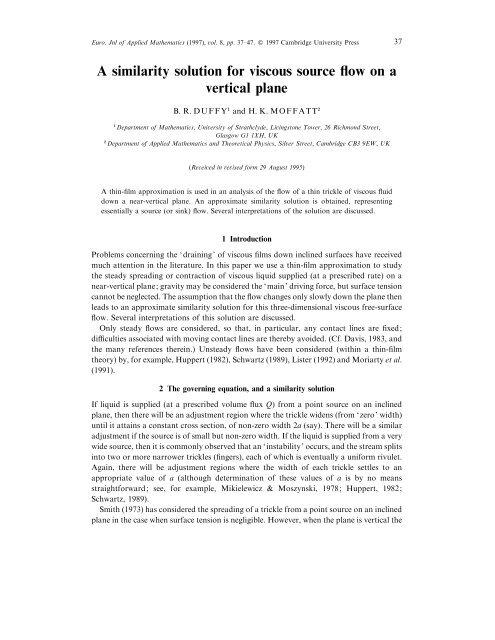


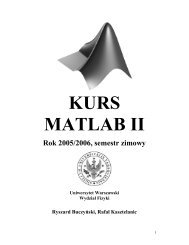
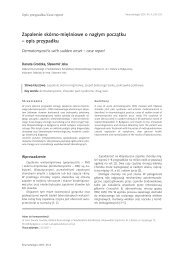
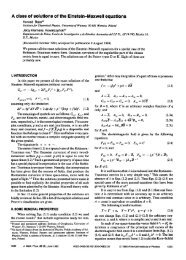
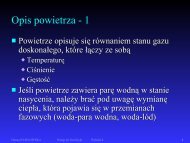
![slajdy [PDF, 0,6 MiB] - Instytut Geofizyki](https://img.yumpu.com/22546539/1/190x143/slajdy-pdf-06-mib-instytut-geofizyki.jpg?quality=85)
